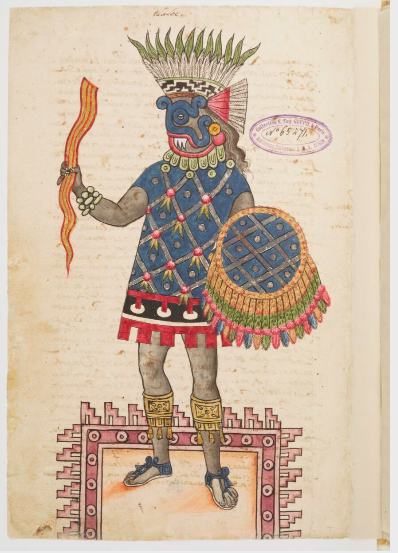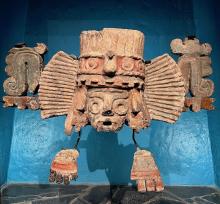Tlaloc (Ixtlil110v)
This example of the iconography of the divine force (or deity) of rain, Tlaloc, is provided here as a detail of the head of the full figure that is shown in the Codex Ixtlilxochitl. We include it here for the purpose of comparing it to hieroglyphs in this database, which tend to be the head only (see below). Note the green (quetzalli) and white heron (aztatl) feathers on the headdress, the black on white geometric steps (called grecas in Spanish) in a patters below that, then a brown band. What appear to be more feathers that are white with red fading to pink appear behind the head, with dark gray wavy hair flowing down the back. The face has swirling blue lines around the mouth and eye, a red-outlined mouth with sharp white fangs (perhaps a phonetic indicator that the name starts with Tla-?), and a red string of hanging green (local jade?) pendants around the neck, which suggest flows of water with droplets/beads at the ends of some of the pendants. Another diagnostic for Tlaloc is what some call a "goggle" eye, an eye with a thick circle around it.
Stephanie Wood
The stepped fret design in black is identified by Ferdinand Anders in his publication of the codex [1976, p. 31] as xicalcoliuhqui. The swirling lines on the face of Tlaloc are the color of water (although a somewhat darker blue here than the water hieroglyphs of the Codex Mendoza, for example). They are also a shape reminiscent of some clouds (see below). Some have seen the curling above the anthropomorphic "mouth" as being like a mustache (especially in one of the Tlaloc guises from Teotihuacan), as noted by Andrew D. Turner, "Unmasking Tlaloc," in Brigitte Faugere and Christopher S Beekman, Anthropomorphic Imagery in the Mesoamerican Highlands (2020), see p. 217. It has also appeared sometimes as a nose ornament (nariguera, in Spanish), such as in the female Tlaloc reproduced by Karla Ramírez Rosas, "Los tocados de Tlaloc en el Códice Borgia," in Sylvie Peperstraete, ed., Image and Ritual in the Aztec World (2009), see p. 66.
Stephanie Wood
tlaloc.
Tlaloc
Stephanie Wood
1578–1650
Stephanie Wood
rain, lluvia, deity, deities, deidades, iconografía, tocados, headdresses, divinities, divinidades, feathers, plumas, colmillos
Tlaloc. "Fragments of a Tlaloc brazier," described by the Museo del Templo Mayor as being fashioned from "red volcanic stone...decorated with ocher, red and blue colors applied to white a white stucco base. It was found on the back side of the Templo Mayor and belongs to Stage IVb (1469-1481 A.S.)." The brazier "shows Tlaloc's face with his typical paper headdress crowned with feathers, as well as symbols related [to] fire such as the xiuhtototl ('turquoise bird'), located on his forehead. The position of the hands is a Teotihuacan-style characteristic, one of multiple Aztec reminiscences from that important cultural tradition." Photograph by Robert Haskett, Museo del Templo Mayor, February 15, 2023.
Tlaloc, rain deity, https://nahuatl.wired-humanities.org/content/tlaloc
xicalcoliuhqui, stepped fret design, https://nahuatl.wired-humanities.org/content/xicalcoliuhqui
Codex Ixtlilxochitl. Bibliothèque nationale de France. Département des Manuscrits. Mexicain 65-71. Gallica digital collection, https://gallica.bnf.fr/ark:/12148/btv1b84701752/
The non-commercial reuse of images from the Bibliothèque nationale de France is free as long as the user is in compliance with the legislation in force and provides the citation: “Source gallica.bnf.fr / Bibliothèque nationale de France” or “Source gallica.bnf.fr / BnF.”








